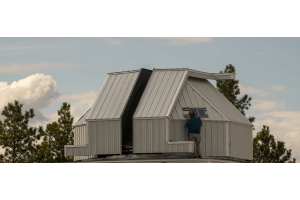
Kids are naturally curious. They’re information sponges, always eager to ask questions and learn...if they’re interested in the topic, of course. The question, then, is how to get kids interested in something you want to teach them, like astronomy. It’s the perfect topic to use to introduce them to the sciences, but only if you can pique that organic curiosity. Here are some ideas to do just that:
Get Them a Telescope
Kids are hands-on learners. They retain information best when they can directly interact with their environment, and nothing lets them get up close and personal with the night sky like a telescope. There are plenty of models for kids out there, but don’t go for something really cheap, since they’ll quickly lose interest if they can’t see anything but blurry dots. To get them excited about using the telescope, don’t make it seem like something educational. Instead, treat “astronomy night” like something special (which it is!). Pop some popcorn, set up blankets and chairs outside, and let them see the entire experience as an adventure. Discover the stars together using an app to guide you, and see what you can see! The first time they spot Saturn through a telescope will be a life-changing experience, as it is for most.

Make a Model of the Solar System
Arts and crafts are always a fun way to introduce concepts in science, and a great place to start is by making a model of the solar system. Paint foam balls the color of the planets while you teach them what the planets are made of, what their names are, how far away they are, and any other facts you can think of. When you’re done, you can even make things to go in your mini solar system, like little rockets and space probes! While you’re making the model, try to depict the spacing of the planets. For example, Mercury will be much closer to the Sun than Neptune or Pluto, so pull up a picture as a reference and see if you can make an (approximately) accurate model of distance.

Watch Videos about Rocket Launches and Missions
If you’ve been lucky enough to witness any of the rocket launches either in person or on TV, you know the amazing feeling they can induce. Recreate these feelings in kids by finding old broadcasts or YouTube videos of more recent launches and explain to them what’s happening and what the mission was about. You can also find a lot of informative videos specifically aimed at kids that describe how rockets work and what happens during a launch.

Bring the Night Sky Inside
If you surround kids with astronomy, they’re bound to take an interest. A great way to bring the wonderful night sky inside so they have a constant reminder of its presence is to add glow-in-the-dark stars to their bedroom ceiling. If you want to, you can go the extra mile and try to recreate some of the constellations and place the planets here and there to help your child learn the layout of the sky. They’ll feel like they’re falling asleep under the stars every night, even when they’re safely tucked inside.

Take Them To A Planetarium
This might be the most powerful way to get kids excited about astronomy. Planetariums hold a special kind of magic even for adults. They immerse you in a world you rarely get to be a part of, and they show you sights you would never have seen otherwise.
The way planetariums work is pretty fantastic. They’re essentially large rooms with theater-like seats which are circular and tilted back rather than facing forward towards a central screen. That’s because the whole ceiling is the screen! The dome-shaped screen helps to recreate the feel and movement of the night sky and surrounds you with stars.
Most planetariums have a regular schedule of shows that talk about a host of different astronomy topics usually aimed at the younger crowd, but they’re enjoyable no matter what age you are. They might cover our solar system, exoplanets, the Milky Way, or more advanced topics like dark matter.

Planetariums are scattered around the world, and a quick Google search should tell you how close you are to the nearest one. Some of the most well-known and popular planetariums are the Adler Planetarium in Chicago, Hayden Planetarium in New York City, and the Morrison Planetarium in San Francisco.
When you think about it, you don’t actually have to work to get kids interested in astronomy. All you need to do is introduce them to the wonders that are out there beyond our planet, and that natural, human curiosity will take over and lead them to explore space on their own.

Learn More
Interested in learning more about astronomy and our universe? Not sure what gear or software you'll need? Check out our Astronomy Hub to learn more!










